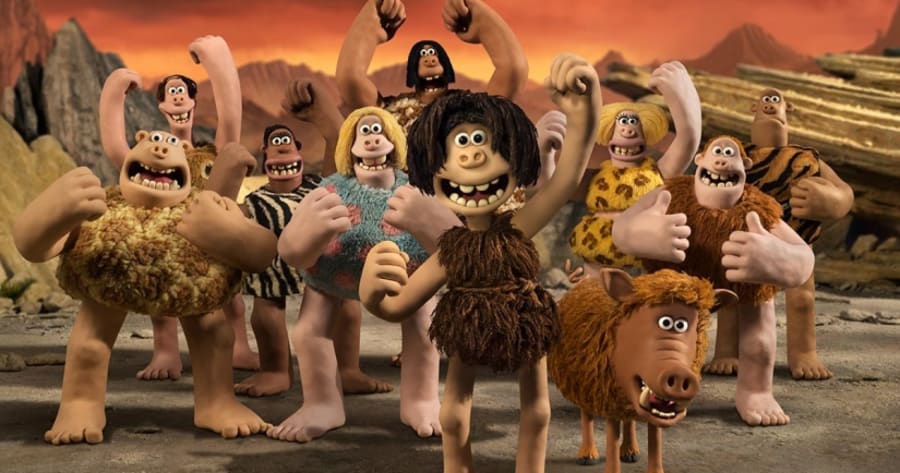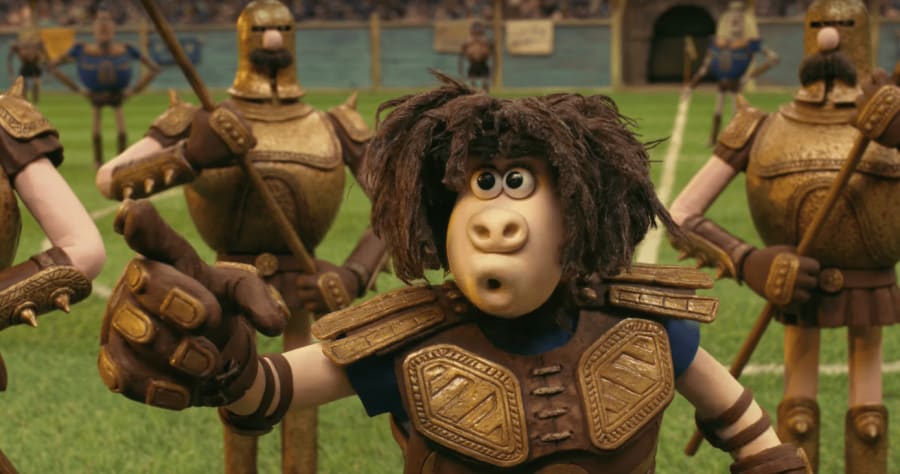 Nick Park is one of the living legends of modern animation and it's very exciting to have a new project from him.
Nick Park is one of the living legends of modern animation and it's very exciting to have a new project from him.
The British filmmaker, a four-time Oscar winner (!), utilized the somewhat outdated notion of stop-motion animation, revamping it for a new generation and taking it into an entirely new direction, with his "Wallace and Gromit" films and "Chicken Run." Stop-motion, the slightly creepy process that had previously been used to bring creatures like living skeletons and skyscraper-climbing apes to life, was now warm, funny, and relatable.
Park's latest stop-motion marvel is "Early Man," a broadly comic tale of cavemen who combat the upcoming arrival of the Bronze Age via a game of soccer, is once again brought to life by the brilliant minds at Aardman Animation. (And yes, it's incredibly British.) It's full of all of the things that make a Nick Park film a Nick Park film – colorful characters, an expressive animal sidekick, visual puns, and elaborately staged set pieces. It's a blast and so much fun to be back in his world.
Last week, Moviefone got the chance to walk around some of the intricately detailed sets for the film, talking with Park about the genesis of the film, why prehistoric characters are so perfectly suited for stop-motion animation, and what's next.
Moviefone: Back when you were working with DreamWorks Animation ...
Park: Ah yes...
... Another animated caveman comedy "The Croods" was originally set up as an Aardman Animation movie, right?
Yes, I believe, in its very early stages. I wasn't really involved in that version of "The Croods." I was on "Were-Rabbit" back then, and it was really after coming out of "Were-Rabbit" I had this quite separate idea of cavemen and the Stone Age and what really sparked it was the invention of soccer.
Did your experience at DreamWorks inform your approach? There has been speculation about their attempts to tone down what you were trying to do.
Well, from my experience, I enjoyed a lot of freedom with "Chicken Run" and "Curse of the Were-Rabbit." But I couldn't say. I don't think things were going too well at that point, generally, between the studios. We all remained friendly. But I learned a lot. With "Chicken Run" -- we'd never made feature films before. So that was very much a learning process, and lots of studio notes all the time. Jeffrey Katzenberg would fly over in his private jet all the time to Bristol, England, to keep an eye on us.
Was there any concern about this story being too British?
There was always a case of "we love what you guys do, but maybe less British?" But now, with this [movie], there was no sense of having to appeal to an American market in particular. There always was with DreamWorks. At first, there wasn't, but then it became more worried about the markets. What I love about this movie is how much you lean into the stop motion of it all, between the way the fur and hair gets disrupted between shots -- and the general elasticity of the characters.
What I love about this movie is how much you lean into the stop motion of it all, between the way the fur and hair gets disrupted between shots -- and the general elasticity of the characters.
Yeah, it's like the fingerprints on the clay. Even stop-frame animators find that stop-frame animators shy away from fur and hair and I actually really wanted that slight twitching effect. They call it "boiling." It reminds me of the old King Kong. It's like the fingerprints. It reminds you that it's hand-crafted.
Obviously there's the legacy, going back to Ray Harryhausen, of prehistoric creatures being brought to life through stop-motion. Why do you think this medium is perfect for that?
That whole subject appealed to me and seemed to suit the medium because the ancient man and the lowbrow -- and just thinking about a bunch of lunk-head cavemen -- somehow the humor comes out of the technique. The crudeness, I guess, and the earthiness.
What was it like casting the film?
Well, that was one of the most exciting bits. Voices have always been important to us at Aardman, since "Creature Comforts." Being able to create clay characters around a good voice has always been really important. We're always looking for something that is extraordinary and different and not too normal. So, yeah, casting was great fun. Eddie Redmayne was great. He does vulnerability well. I wanted him to be a shy but enthusiastic teen.With Tom Hiddleston, I was watching him on a talk show in the UK called "The Graham Norton Show." And he was on with Robert De Niro, and he was doing impressions and imitated De Niro really well. So, I wondered if he'd do a voice. I know he's not the first person you think of when you're casting a large, pompous Frenchman. But it worked. He really loved doing it. He can do anything. We were slightly worried at one point that when the whole Brexit happened, it may feel like we were being anti-European. Tom was concerned. So we tried him being English, but it sounded too typical because there are so many English villains. Even the StudioCanal guys in Paris preferred the French. So we went back to that.
And you were able to use some CGI alongside the stop-motion, right?
Yeah, it's a whole mixture. We did have some CGI animation, but a lot of digital effects. Like, we only built one of these mammoths -- so when you see three mammoths in a shot, it's just one mammoth that's been composited three times. We've adapted digital technology throughout the movies, mostly for stuff that you can't do in clay, like fire and water. It allowed us, in "Early Man," to create truly epic stuff like lava. We had thirty or forty different sets going at one time, so oftentimes we would shoot against green screen and put in skies afterwards.
How do you make the decision for what to make digital and what to do practically?
Well, in this one, we wanted to keep it hands-on and do everything in camera if we can. Even on some of the water effects, it'd be great to keep it in the old way, like using cling film. It has a nice, fluid effect. With the foam it was hair gel mixed with glass beads, on little mechanisms that can rise up and down with each frame.
Amazingly, this is one of two big stop-motion movies coming out in the next couple of months. Why do you think the format still persists?
It's incredible, isn't it? There's almost a renaissance of stop-frame. I didn't expect it. Even 20, 30 years ago, with the first "Toy Story," we were thinking, "How much time do we have left with stop-frame?" But it hasn't happened yet. It actually helps us stand out and make our mark.
Do you ever get tired of it?
No, I never do. I feel like I belong to the stop-frame. There's something that happens, with the look and the feel, when I'm writing I'm thinking of stop-frame and things that would look good -- like the giant duck! I know you could easily create a giant duck in CG, but I wanted it to have a bad taxidermy effect.
What's next?
We have another "Shaun the Sheep" movie coming out. A lot of the animators have moved onto that. That's the next big one coming out for us.
"Early Man" opens this Friday, everywhere.
from Moviefone News RSS Feed - Moviefone.com http://ift.tt/2F0Dv88
via IFTTT
No comments:
Post a Comment